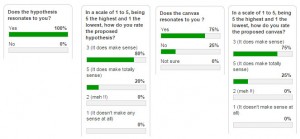First of all, I wish you a happy, healthy and generous 2015 to you and your families.
In my latest post I through a challenge to all of you, asking your for your help to validate the foundations of my new project called “Agile Team Development Canvas, Coaching teams from forming to performing & more”. I wanted to confirm these two aspects in particular:
1) How resonant my hypothesis was.
2) if the Agile_Team_Development_Canvas-Coaching_Teams-From_Forming_To_Performing_and_more made any sense.
Here the results that I’ve got so far:
With those results at hand, I’ve started my first two (2) weeks experiment:
Context
All experiments and observations that follow, were done with a mature Scrum team composed by seven(7) developers, one (1) Product Owner and me acting as their Agile Coach/Scrum Master, that I can confirm seems to be at the “Performing” stage of Tuckman’s development group model.
Challenge
– How do we integrate a new developer (John) into a performing team without creating a massive impact on their current development stage?
Questions?
– What is the current team stage based on Tuckman’s group development model ?
– What kind of tools could we use to get:
1) John successfully integrated into the team
2) Mitigate John’s integration impact on team’s development current stage
Tools
Here some of the tools & tricks we’d used, to facilitate John’s integration into the team,
a) First of all, the team was part of John’s selection and hiring process. Once Human Resources completed psychological and technical profile verification, company fit, etc, the last step of the hiring process is to validate John’s fitting within the team. So we’d organized a one(1) meeting were John shared valuable time with his future colleges. After that, team’s opinion about John being part of the team, and 90% said yes, so he was hired and two weeks after John was ready to start working with us.
b) An integration plan was developed and shared with the team. (See observations about it)
b.1) An Agile and Scrum introduction was required for John.
b.1.1) We hold one (1) hour session to play Agile Values & Principles-Discuss-Reflect-Map-exercise with John.
b.1.2) John went through Read, learn, then reflect exercise (using Mike Cohn’s Scrum material):
- Scrum-Introduction-Mike-Cohn
- Agile-Estimating
- User-Stories-for-Agile-Requirements
- Advanced-Agile-Planning
- Agile-Seven-Deadly-Sins
c) John’s team integration was completed by dedicating a full sprint retrospective to play Personal Maps from Management 3.0 workout. Awesome way to get to know people around you, even between friends !
d) I proposed the team to revise team’s Code_of_Conduct_Alliance_Attitudes_Agreements-Strategies-for-dealing-with-dysfunctional-behavior-template.pdf, but we couldn’t make it. I strongly recommend you to do it, to reduce future conflicts within the team.
Observations
– Powerful questioning & leadership style
What I used the most at the beginning was a little bit of “Telling” leadership style to guide the team with how to deal with some parts of John’s integration process, after the first week they took full control of John’s integration process. From the arc of the coaching conversation, I went back to the “exploring” phase, to help the team shares its development process in detail with John, so What type of questions where commonly used to refresh what do we do and how do we do things within the team.
– People’s behavior
I’d observed that it could be a relationship between the amount of people within the team versus how long it takes to make a decision, in this case, having a John within the team, has raised the flag again about decisions are made within the team. Something that I’ll explore more deeply in future iterations.
I’d notice also, that during the first week John was observing everything, likewise the team. Once we hit the second week and the trust relationship had established, then I was able go back to the kind of questions that I use when the team was in the performing stage, the team started taking John into its dynamics, John started to participate and share his point of view with the rest of the team.
Models that I’ve used
- The arc of the coaching conversation, Sue Johnston version of Lyssa Askins Coaching Agile Teams book sketch.
- Hersey & Blanchard Situational Leadership Theory
- Tuckman’s group development Model
Research & additional references
- Faculty & Research working paper, Assessment tools for developing & leading effective teams. Randel S. Carlock, 2012
- Michel Moral Team coaching, Team maturity scales
I’ve already started Agile Team Development Canvas second (2nd) iteration, and I’m more than excited to share what I’ll be observing and trying during the next weeks to come.
Thoughts ? Ideas ? Tools ?
All the best,
Jesus









